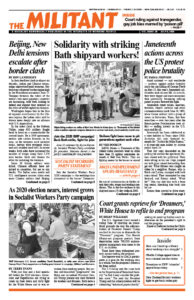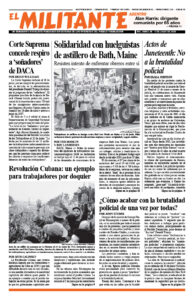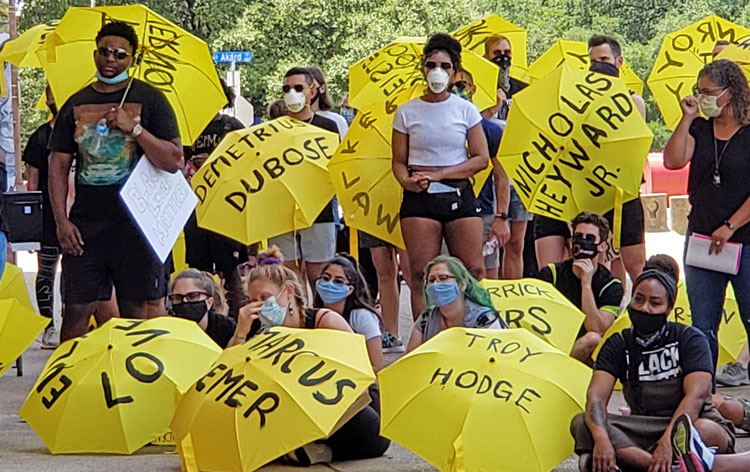Amid national — and worldwide — protests against police brutality since the cop killing of George Floyd on May 25, this year’s Juneteenth celebrations took on new life. As a result, they were bigger and more numerous than previously, becoming rallying points to press forward the fight.
Juneteenth street rallies, marches, festivals, church services and other commemorations mark June 19, 1865, when Union soldiers told a group of slaves in Galveston, Texas, that they were free — over two years after the Emancipation Proclamation took effect — ending slavery in the U.S. once and for all.
Juneteenth has been celebrated as a state holiday in Texas since 1980. Activities this year featured demands for “Justice for Mike Ramos,” a 42-year-old man killed by Austin police April 24.
That day cops descended on the parking lot outside the apartment Ramos shared with his girlfriend. They were sitting in his car. Cops jumped out with guns raised demanding they get out. What follows was caught on video by a neighbor. Ramos, who is Black and Latino, emerged with both arms raised. They demanded he step forward, and Ramos asked, “What for?” One cop shot him with a bean bag round, knocking him back into his car.
Ramos then started to drive away. Officer Christopher Taylor raised his rifle, as neighbors yelled, “Don’t shoot, don’t shoot.” He opened fire, hitting Ramos three times, killing him. Ramos was found to have had no weapon.
The cops say they have a video of the shooting, but have so far stalled on releasing it. No action has been taken against the cops.
Protests demanding charges against the cops involved in the killing of Ramos have been organized in Austin and across Texas. His name was one of 239 names of victims of cop killings displayed on yellow umbrellas at a rally of hundreds outside City Hall in Dallas on Juneteenth, as the city entered its third week of daily demonstrations.
Killing of Tony Timpa covered up
At one of the actions Dallas Police Chief U. Renee Hall had taken a knee along with the protesters.
“When you see the chief take a knee, and she still employs officers who took a knee on Tony Timpa’s neck, it’s just performance art,” Sara Mokuria, co-founder of Mothers Against Police Brutality, told the City Hall rally.
Timpa was killed by Dallas cops in 2016 after he called 911 to tell them he was schizophrenic, depressed and off his meds, and needed help. They came and put him down on the ground, handcuffed, zip-tied his legs together, and pressed on his body, arms and neck for nearly 14 minutes. Timpa cried out more than 30 times, saying, “You’re gonna kill me!” before he stopped moving.
After he passed out, the cops made fun of him. He died.
The cops were indicted by a grand jury, but the district attorney dropped the charges. The facts only became public this year after city officials lost a three-year-long fight to keep hidden the cops’ body camera videos of the killing.
In many other cities across the country, protests that began after George Floyd was killed have provided a voice for local fights against new and some longstanding cases of cop brutality. Calls for the prosecution of the cops who killed Breonna Taylor, an African American shot dead in a “no knock” late night cop raid on her apartment in Louisville, Kentucky, March 13, are increasingly being heard at protests.
In Atlanta, protests that started after the killing of Floyd expanded when cops killed Rayshard Brooks there June 12, continuing to draw thousands over the Juneteenth weekend.
Since the cops who killed Floyd have been fired, arrested and serious charges filed against them, many continuing protests have taken place under generalized slogans, like “Black Lives Matter,” “No justice, no peace” and “No time to hate,” as opposed to concrete demands for action against brutal cops.
Many have become the occasion for discussion and debate over various liberal schemes for reforming the police. These include calls to “Defund the police,” and for “Police service, not police forces.” Or they focus on efforts to elect Democratic presidential candidate Joe Biden to get rid of President Donald Trump.
But there is no way to “improve” the conduct of the cops, whose function under capitalism is to mete out punishment to working people to protect the profits, property and power of the ruling capitalist class. The only road to get rid of police brutality once and for all is to organize working people in their millions to take political power into their own hands. Socialist Workers Party campaigners at the actions explain how this can be seen today in the revolution made by Cuban workers and farmers.
Protests spread into the countryside
During the recent wave of protests, hundreds of actions have been organized nationwide in smaller cities and towns, often initiated by high school students. And many have taken place in communities with a majority Caucasian population in rural areas.
These are the places liberal politicians and media denigrate as “flyover country,” inhabited by working people Hillary Clinton dismissed in 2016 as “deplorables,” racists, sexists and xenophobes.
Day after day working people and youth in these communities have taken to the streets helping to protest police violence, putting a lie to the contempt that liberal politicians and commentators hold them in.
Louise Goodman reported to the Militant from Central Oregon that actions against police brutality have continued there since the killing of George Floyd. In Prineville, a city of 11,000, almost 400 people marched and rallied at the courthouse June 20. A counterprotest a quarter of the size gathered across the street to support local cops.
In Bend, the biggest city in the area, with less than 500 Blacks out of a population of 100,000, there have been a number of protests of over 1,000. This was the first Juneteenth celebration in the city. Some 800 protesters joined a “Take Back the Butte March” to Pilot Butte, the site of two 1923 cross burnings by the Ku Klux Klan.
“Security monitors and medics were there to help keep the actions safe and peaceful,” Goodman wrote.
These protests in smaller towns and villages all across the country are an important reflection of the powerful impact on workers’ thinking of the Black-led mass movement that overthrew Jim Crow segregation in the 1950s and ’60s and protests since.
To try to counter this fact, the liberal press focused on a small number of mobilizations by armed right-wing groups. “Militia activity has marked protests in places across the country,” claimed Isaac Stanley-Becker in the Washington Post. He alleges activity by militias in rural areas and small towns is widespread, intimidating organizers to call off actions there.
In reality the breadth of demonstrations across the country over three weeks has been unprecedented. The Post ’s real intent is to tar working people in rural areas as deplorable.


